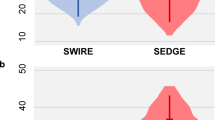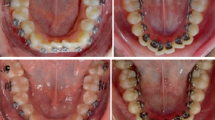Abstract
Purpose
To evaluate orthodontic treatment outcome in patients treated with a lingual appliance (Incognito™ Appliance System, 3M Unitek, Monrovia, CA, USA) versus patients treated with a labial appliance (Victory series™, 3M Unitek, Monrovia, CA, USA).
Methods
A total of 72 patients were retrospectively analyzed. The complexity of each case was evaluated using the American Board of Orthodontics (ABO) Discrepancy Index (DI), and orthodontic clinical outcomes were evaluated using the ABO Objective Grading System (cast-radiograph evaluation: C‑R Eval).
Results
The mean total ABO C‑R Eval score was 16 ± 9.1 in the labial appliance group and 12.7 ± 5.4 in lingual appliance group (p = 0.152). The mean total ABO-DI scores were 16.3 ± 7.3 and 15.4 ± 6.6 in the labial and lingual appliance groups, respectively (p = 0.445). A significant correlation was observed between the total DI and total C‑R Eval scores.
Conclusions
In this particular study and in the hands of two experienced orthodontists, no differences in the finishing quality of orthodontic treatments using the lingual technique or the buccal appliance technique were found. However, further prospective studies with larger sample sizes are necessary in order to generalize these results.
Zusammenfassung
Zielsetzung
Evaluierung des kieferorthopädischen Behandlungsergebnisses bei Patienten, die mit einer Lingualapparatur (Incognito™ Appliance System, 3M Unitek, Monrovia/CA, USA) behandelt wurden, im Vergleich zu Patienten, die mit einer Labialapparatur (Victory series™, 3M Unitek, Monrovia/CA, USA) behandelt wurden.
Methoden
Insgesamt 72 Patienten wurden retrospektiv analysiert. Die Komplexität jedes Falles wurde mithilfe des Diskrepanzindex (DI) des American Board of Orthodontics (ABO) bewertet, und die kieferorthopädischen klinischen Ergebnisse wurden mit dem ABO Objective Grading System (Bewertung von Cast-Röntgenaufnahmen) bewertet („cast-radiograph evaluation“, C‑R Eval).
Ergebnisse
Der mittlere Gesamtwert des ABO C‑R Eval betrug 16 ± 9,1 in der Gruppe der Labialapparaturen und 12,7 ± 5,4 in der Gruppe der Lingualapparaturen (p = 0,152). Der mittlere ABO-DI-Gesamtwert betrug 16,3 ± 7,3 bzw. 15,4 ± 6,6 in der Gruppe der Labial- und Lingualapparaturen (p = 0,445). Es wurde eine signifikante Korrelation zwischen dem Gesamt-DI- und dem Gesamt-C-R-Eval-Score beobachtet.
Schlussfolgerungen
In dieser speziellen Studie und in den Händen zweier erfahrener Kieferorthopäden ließen sich keine Unterschiede in der Qualität des kieferorthopädischen Finishings mit der Lingualtechnik bzw. der bukkalen Apparatetechnik feststellen. Um diese Ergebnisse zu verallgemeinern, sind jedoch weitere prospektive Studien mit größeren Stichprobengrößen erforderlich.



Similar content being viewed by others
References
Ponduri S, Pringle A, Illing HM, Brennan PA (2011) Peer assessment rating (PAR) index outcomes for orthodontic and orthognathic surgery patients. Br J Oral Maxillofac Surg. https://doi.org/10.1016/j.bjoms.2010.03.009
Chalabi O, Preston CB, Al-Jewair TS, Tabbaa S (2015) A comparison of orthodontic treatment outcomes using the Objective Grading System (OGS) and the Peer Assessment Rating (PAR) index. Aust Orthod J 31:157–164
Bichara LM, Aragón ML, Brandão GA, Normando D (2016) Factors influencing orthodontic treatment time for non-surgical Class III malocclusion. J Appl Oral Sci. https://doi.org/10.1590/1678-775720150353
Cansunar HA, Uysal T (2014) Relationship between pretreatment case complexity and orthodontic clinical outcomes determined by the American Board of Orthodontics criteria. Angle Orthod 84:974–979. https://doi.org/10.2319/010114-001.1
Chaison ET, Liu X, Tuncay OC (2011) The quality of treatment in the adult orthodontic patient as judged by orthodontists and measured by the Objective Grading System. Am J Orthod Dentofacial Orthop 139(4 Suppl):69–75. https://doi.org/10.1016/j.ajodo.2009.07.018
Struble BH, Huang GJ (2010) Comparison of prospectively and retrospectively selected American Board of Orthodontics cases. Am J Orthod Dentofacial Orthop 137(1):6.e1–6.e8. https://doi.org/10.1016/j.ajodo.2009.05.016
Parrish LD, Roberts WE, Maupome G, Stewart KT, Bandy RW, Kula KS (2011) The relationship between the ABO discrepancy index and treatment duration in a graduate orthodontic clinic. Angle Orthod 81(2):192–197. https://doi.org/10.2319/062210-341.1
Liu S, Oh H, Chambers DW, Baumrind S, Xu T (2017) Validity of the American Board of Orthodontics Discrepancy Index and the Peer Assessment Rating Index for comprehensive evaluation of malocclusion severity. Orthod Craniofac Res 20:140–145. https://doi.org/10.1111/ocr.12195
Campbell CL, Roberts WE, Hartsfield JK Jr, Qi R (2007) Treatment outcomes in a graduate orthodontic clinic for cases defined by the American Board of Orthodontics malocclusion categories. Am J Orthod Dentofacial Orthop 132:822–829
Vu J, Pancherz H, Schwestka-Polly R, Wiechmann D (2012) Correction of Class II, Division 2 malocclusions using a completely customized lingual appliance and the Herbst device. J Orofac Orthop 73:225–235. https://doi.org/10.1007/s00056-012-0077-0
Deguchi T, Terao F, Aonuma T, Kataoka T, Sugawara Y, Yamashiro T, Takano-Yamamoto T (2015) Outcome assessment of lingual and labial appliances compared with cephalometric analysis, peer assessment rating, and objective grading system in Angle Class II extraction cases. Angle Orthod 85:400–407. https://doi.org/10.2319/031014-173.1
Vandenbroucke JP, von Elm E, Altman DG, Gøtzsche PC, Mulrow CD, Pocock SJ, Poole C, Schlesselman JJ, Egger M, Initiative STROBE (2007) Strengthening the Reporting of Observational Studies in Epidemiology (STROBE): explanation and elaboration. Epidemiology 18:805–835
Ata-Ali F, Plasencia E, Lanuza-Garcia A, Ferrer-Molina M, Melo M, Ata-Ali J (2019) Effectiveness of lingual versus labial fixed appliances in adults according to the Peer Assessment Rating index. Am J Orthod Dentofacial Orthop 155:819–825
Casko JS, Vaden JL, Kokich VG, Damone J, James RD, Cangialosi TJ, Riolo ML, Owens SE Jr, Bills ED (1998) Objective grading system for dental casts and panoramic radiographs. American Board of Orthodontics. Am J Orthod Dentofacial Orthop 114:589–599
American Board of Orthodontics (2019) https://www.americanboardortho.com/media/5292/121218aboclinicalexamstudyguide.pdf. Accessed 24 Feb 2019
Cangialosi TJ, Riolo ML, Owens SE Jr, Dykhouse VJ, Moffitt AH, Grubb JE, Greco PM, English JD, James RD (2004) The ABO discrepancy index: a measure of case complexity. Am J Orthod Dentofacial Orthop 125:270–278
Dahlberg G (1940) Errors of estimation. In: Statistical methods for medical and biological students, 1st edn. George Allen & Unwin LTD, London, pp 122–132
Fleiss JL (1986) The design and analysis of clinical experiments. John Wiley, New York, pp 241–260
Okunami TR, Kusnoto B, BeGole E, Evans CA, Sadowsky C, Fadavi S (2007) Assessing the American Board of Orthodontics objective grading system: digital vs plaster dental casts. Am J Orthod Dentofacial Orthop 13:51–56
Detterline DA, Isikbay SC, Brizendine EJ, Kula KS (2010) Clinical outcomes of 0.018-inch and 0.022-inch bracket slot using the ABO objective grading system. Angle Orthod 80:528–532. https://doi.org/10.2319/060309-315.1
Fujita K (1979) New orthodontic treatment with lingual bracket mushroom arch wire appliance. Am J Orthod 76:657–675
Ata-Ali F, Ata-Ali J, Ferrer-Molina M, Cobo T, De Carlos F, Cobo J (2016) Adverse effects of lingual and buccal orthodontic techniques: a systematic review and meta-analysis. Am J Orthod Dentofacial Orthop 149:820–829. https://doi.org/10.1016/j.ajodo.2015.11.031
Pulfer RM, Drake CT, Maupome G, Eckert GJ, Roberts WE (2009) The association of malocclusion complexity and orthodontic treatment outcomes. Angle Orthod 79:468–472. https://doi.org/10.2319/042308-227.1
Cameron D (2010) The relationship between American Board of Orthodontics pretreatment dental cast Discrepancy Index scores and posttreatment dental cast Objective Grading System scores. Master’s thesis, Faculty of the Graduate School of Saint Louis University, St. Louis, Missouri, USA
Papageorgiou SN, Koretsi V, Jäger A (2017) Bias from historical control groups used in orthodontic research: a meta-epidemiological study. Eur J Orthod 39:98–105. https://doi.org/10.1093/ejo/cjw035
Holmes A (1992) The subjective need and demand for orthodontic treatment. Br J Orthod 19:287–297
Rosvall MD, Fields HW, Ziuchkovski J, Rosenstiel SF, Johnston WM (2009) Attractiveness, acceptability, and value of orthodontic appliances. Am J Orthod Dentofacial Orthop 135:276.e1–276.12
Author information
Authors and Affiliations
Corresponding author
Ethics declarations
Conflict of interest
F. Ata-Ali, J. Ata-Ali, A. Lanuza-Garcia, M. Ferrer-Molina, M. Melo and E. Plasencia declare that they have no competing interests.
Ethical standards
The Ethics Committee of University of Valencia (Spain) approved this study. All procedures performed in the study involving human participants were in accordance with the ethical standards of the institutional research committee and with the 1964 Helsinki declaration and its later amendments. Informed consent was obtained from all individual participants included in the study (Reference: H1475013776580).
Rights and permissions
About this article
Cite this article
Ata-Ali, F., Ata-Ali, J., Lanuza-Garcia, A. et al. Clinical outcomes of lingual fully customized vs labial straight wire systems. J Orofac Orthop 82, 13–22 (2021). https://doi.org/10.1007/s00056-020-00248-0
Received:
Accepted:
Published:
Issue Date:
DOI: https://doi.org/10.1007/s00056-020-00248-0
Keywords
- Discrepancy Index
- Objective Grading System
- Dental occlusion
- Orthodontic treatment outcome
- Fixed orthodontic appliances




